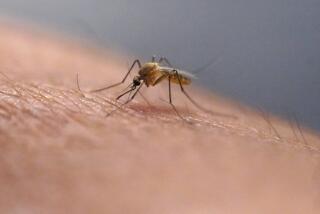Little Danger, but Plenty of Aggravation, Seen From Mosquitoes
- Share via
The rain and floods brought by Hurricane Katrina are sparking an outbreak of mosquitoes, but health authorities say an accompanying outbreak of disease is unlikely.
The cycle of disease is fragile. Although Katrina brought the water necessary for mosquitoes to breed, it also wiped out many of the elements needed for disease to spread, said Roger Nasci, head of the Centers for Disease Control and Prevention’s entomology team on the Gulf Coast.
Transmission of West Nile virus, for example, requires a relatively narrow range of bird hosts, weather conditions and species of mosquitoes -- all of which were disrupted by the hurricane.
“When 120-mph winds come through, everything leaves,” said Joe Conlon, technical advisor to the American Mosquito Control Assn. in North Brunswick, N.J. “We don’t anticipate a spike in West Nile fever.”
Most victims of West Nile suffer no symptoms of the infection. The rest can experience fever and nausea for several weeks. Fewer than 1% of cases result in death, according to the CDC.
No cases of West Nile virus have been detected since the storms, said Kristen Meyer, a spokeswoman for the Louisiana Department of Health and Hospitals in Baton Rouge.
Experts said other mosquito-transmitted illnesses, such as St. Louis encephalitis, Eastern equine encephalitis, LaCrosse virus, dengue fever and malaria, were also unlikely because they were rare to begin with.
The biggest problem with the mosquito outbreak is likely to be the sheer annoyance of it all.
Summer heat, coupled with the lack of electricity to power air conditioners, means that it will be hard for people to shut out the bugs.
“You can’t stay in the house because its too hot -- the power’s off.... You can’t cover up because you burn up,” said Jerome Goddard, chief entomologist for the Mississippi Department of Health. “You just want to scream.”
The storm has created plentiful breeding opportunities for mosquitoes; all they need is a teacup-sized puddle.
Countless trees have blown over and “when the trees go down, there is a huge cavity left where the root ball was lifted out,” said Matthew M. Yates, mosquito abatement director for East Baton Rouge Parish in Louisiana. “The rain fills those cavities, leaf litter covered with mosquito eggs fills them, and those are great breeding grounds.”
About 60 species of mosquitoes are present in Louisiana. Some, such as the Southern house mosquito, thrive in sewage-contaminated water.
Others prefer ponds that form in the foundations of wrecked houses inundated by brackish water.
Some mosquitoes can grow from eggs to biting adults in four days.
The region is mobilizing to kill the mosquito larvae before they hatch, although workers are hampered by fuel shortages, blocked roadways and a host of other problems. Many remote areas are inaccessible to trucks even under the best of circumstances.
New Orleans Mayor C. Ray Nagin has asked the federal government for crop dusters to spray the city.
The CDC is coordinating with the military to send in C-130 Hercules transport planes fitted with tanks to spray pesticides over storm-flattened areas.
Mississippi entomologists bought 300 cases of “mosquito dunks” -- disks that look like miniature doughnuts and release Bacillus thuringiensis, a bacterium harmless to people, fish and animals, but deadly to mosquito larvae.
Abatement teams are fanning out across the state to float the dunks in every pool of water they spot.
The work is expected to go on for months.
Authorities are recommending that residents cover themselves with DEET-based repellents.
More to Read
Sign up for Essential California
The most important California stories and recommendations in your inbox every morning.
You may occasionally receive promotional content from the Los Angeles Times.













